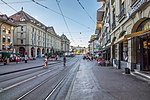Hotel Bellevue Palace
1913 establishments in Switzerland19th-century architecture in Switzerland20th-century architecture in SwitzerlandBuildings and structures in BernCompanies owned by the federal government of Switzerland ... and 9 more
DiplomacyHotel buildings completed in 1865Hotel buildings completed in 1913Hotels in SwitzerlandMilitary history of SwitzerlandState guesthousesSwiss companies established in 1913The Leading Hotels of the WorldTourism in Bern

The Bellevue Palace is a five-star luxury hotel located in the Old City of Bern, Switzerland. Owned by the Swiss Confederation, it is the state's guesthouse for visiting heads of state and government, and is host to dozens of members of parliament during the weeks the assembly is in session.
Excerpt from the Wikipedia article Hotel Bellevue Palace (License: CC BY-SA 3.0, Authors, Images).Hotel Bellevue Palace
Kochergasse, Bern
Geographical coordinates (GPS) Address Website External links Nearby Places Show on map
Geographical coordinates (GPS)
| Latitude | Longitude |
|---|---|
| N 46.9466 ° | E 7.4466 ° |
Address
Bellevue Palace (Hotel Bellevue Palace AG)
Kochergasse 3-5
3011 Bern (Stadtteil I)
Bern, Switzerland
Open on Google Maps









